Welcome to Club SAITO !
Senior Member
Hello all I have a few questions for this group both are about props, I have a FA-91 going on the front of a Ultra Sport 60 what prop do I need to run for it the book says a 11x11 for the .91 4 stroke but isnt that too small for th3 .91 and if so what prop should I run, also I have a RCFW F6F-5 Hellcat and am planning on running a Saito 125 on it but what three blade prop will i need to spin I was looking at a 16x10 or the 16x8. and last one of the squadron mates is building a TF GE P-51 what is the biggest 4 blade prop can he spin on the 125.
A 12 X 11 will bring RPM down to about 9800 on the ground & still generate almost 6# of thrust.
I recently converted an FA125 to CDI & on GI (hlow ignition) it would not sustain WOT W/a 16 X 8 prop. It would get too hot & backfire, spitting the prop loose. W/GI 15 X 8 or 14 X 10 is about max.
Last edited by SrTelemaster150; 02-24-2014 at 09:04 AM.
I have also seen reference to silicone content o-rings in other engines like OS (I think) and not to use after run oil. More often than not I think the red o-rings are silicone content too. Google that term, "silicone o-rings" and take a peek at all that comes up.
Thanks very much for the kind words ken.
I'm not sure what you are getting at ernie.If you pump an ounce of aro in thru the crankcase breather nipple and spin the engine over with a starter your done,it's a set and forget thing.There's no o rings to damage down there and in any event i've never had any problems.Anyone who has please let us know.
I'm not sure what you are getting at ernie.If you pump an ounce of aro in thru the crankcase breather nipple and spin the engine over with a starter your done,it's a set and forget thing.There's no o rings to damage down there and in any event i've never had any problems.Anyone who has please let us know.
From what I understand, AO is only used on the bottom end to lubricate the bearings and remove any water absorbing leftovers from the fuel, never to be used in the top end.
Senior Member
It is sometimes a practice to remove the rocker covers & drip some ARO down the pushrod tubes & into the glow plug hole when storing during the off season.

My Feedback: (3)
I like the idea of using a fogger. I just need to remember to stop by NAPA and get a can. I've never used ARO myself, but I am going to start using the stuff Hobbsy suggests.
I must use ARO different than some folks. Especially when storing an engine I fill it up good and it winds up everywhere. I put a few drops on the carb barrel as well and I think that is what caused a needle o-ring to swell up on me. Sometimes when I get home from flying I'll prop the plane up so the engine jug is facing straight down and let sit that way for a couple of weeks or more. The ARO will eventually work it's way past the cam area and up into the rocker boxes.
Anyone ever go back and read all of William Robisons's notes? I did that the other day and I'm always amazed at his way of getting the point across so simply. He was actually a very good writer considering his main career was mechanics. I think it mentioned he did teach at one time though.
Anyone ever go back and read all of William Robisons's notes? I did that the other day and I'm always amazed at his way of getting the point across so simply. He was actually a very good writer considering his main career was mechanics. I think it mentioned he did teach at one time though.
I like the idea of foggers too. I used the CRC brand sold at marinas for quite a while. Since the can is pressurized you can put the piston at BDC and inject under pressure and it will force the piston up to TDC giving you a good amount of oil in the crankcase.

My Feedback: (3)
I've had rusted bearings in just one engine, and that one burned only synthetic oil. I've used castor pretty much 100% of the time since then.
Bill is certainly missed.
Bill is certainly missed.
Senior Member
And I have stored engines for 14 years that were run exclusively on full syntetic Cool Power.
Here's what condition I found the rear bearing in when I had to replace a crash damaged front bearing.

I also came across an interesting article about castor Vs synthetic oil.
Here's a few snips from it.
Why use synthetic oil?
Synthetic oils typically offer high film strength without the wax formation. Wax formation can be undesirable in ringed engines where the wax build up can result in ring sticking which will lead to a ring failure and subsequent engine failure. Synthetic oils also tend to keep the insides of the engines cleaner which results in more consistent combustion.
Some people have argued that Castor oil is better than synthetic oil. Historically this argument stems from the manufacturing process of rc engines. Why is this?
If we consider the demographics of the RC hobby, I think you’ll find it s is mostly 40 to 60 something’s who are most active. When these folk started in the hobby, manufacturing techniques where not dominated by CNC (Computer Numerical Control) machinery but by manned lathes and mills. Engines were mostly cast and liners were not very accurate. These components were not “close fit” as they are today. The use of castor oil would result in a varnish layer on the components that effectively took up some of the tolerance and provided sealing and hence compression.
What is one benefit to using Castor?
It is fairly easily available over the counter and it lubricates well enough.
What is one benefit to using synthetic?
Synthetics oils tend to be more thermally stable at the operating temperatures of RC engines and they don’t leave residue behind in the engine.
Here's what condition I found the rear bearing in when I had to replace a crash damaged front bearing.

I also came across an interesting article about castor Vs synthetic oil.
Here's a few snips from it.
Why use synthetic oil?
Synthetic oils typically offer high film strength without the wax formation. Wax formation can be undesirable in ringed engines where the wax build up can result in ring sticking which will lead to a ring failure and subsequent engine failure. Synthetic oils also tend to keep the insides of the engines cleaner which results in more consistent combustion.
Some people have argued that Castor oil is better than synthetic oil. Historically this argument stems from the manufacturing process of rc engines. Why is this?
If we consider the demographics of the RC hobby, I think you’ll find it s is mostly 40 to 60 something’s who are most active. When these folk started in the hobby, manufacturing techniques where not dominated by CNC (Computer Numerical Control) machinery but by manned lathes and mills. Engines were mostly cast and liners were not very accurate. These components were not “close fit” as they are today. The use of castor oil would result in a varnish layer on the components that effectively took up some of the tolerance and provided sealing and hence compression.
What is one benefit to using Castor?
It is fairly easily available over the counter and it lubricates well enough.
What is one benefit to using synthetic?
Synthetics oils tend to be more thermally stable at the operating temperatures of RC engines and they don’t leave residue behind in the engine.
Last edited by SrTelemaster150; 02-25-2014 at 05:36 PM.

My Feedback: (2)
Join Date: Dec 2001
Location: Kerrville,
TX
Posts: 2,127
Likes: 0
Received 0 Likes
on
0 Posts
I have used Automatic Transmission Fluid (ATF) for years, in storing engines. I started using it when I found a need to preserve the seals, etc, in YS engines.
CR
CR

My Feedback: (102)
Join Date: Dec 2001
Location: Colonial Beach, VA
Posts: 20,370
Likes: 0
Received 25 Likes
on
25 Posts
As said, synthetics don't leave anything behind and that's the exact reason that the rust occurs. This is one such bearing from my newly acquired 1.00. I also mentioned before that the 1.00 was bone dry inside.
Senior Member
That's just not true.
Here is the piston from that FA91S run on 100% synthetic lube stored for 14 years as it came from the engine.
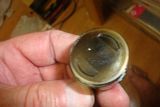
Here is the same piston after I wiped the oil from the crown W/my finger. Note the oil on my fingers.
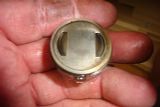
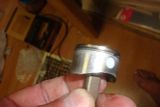
You're right though. Synthetics don't leave as much behind as castor.
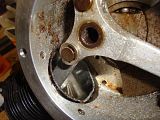
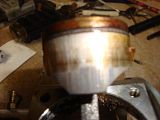
That's precisely why I don't use castor.
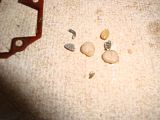
Last edited by SrTelemaster150; 02-26-2014 at 08:16 AM.

My Feedback: (3)
Dan, I think most of the arguments against castor are from the old days when people ran 100% castor, and FAI rules. But there is no argument that castor prevents rust and protects better above something like 475 F lean runs. Of course you are going to get some build up using too much and running engines smoking rich all the time. So, pick your poison. Some build up if you run too rich with 100% castor, or burnt up engines and rust if you run too lean with 100% synthetics.
Member
Join Date: Jan 2010
Location: Winston-Salem, NC
Posts: 36
Likes: 0
Received 0 Likes
on
0 Posts
I have a 3 yr. old Saito 115. Used once or twice a month, ALWAYS used ARO (Marvel Mystery Oil and ATF, mixed 50-50). I'd hardly say this engine was treated roughly - aprox. 10 minute flights, never lean. The cam gear stripped in 2 places the other day - one large area and one are just a couple teeth. I could hear a rough sound when flying but thought it was a loose wheel/cowling. Landed the plane with no problem but found no compression at all once at home. HH repaired at no charge < 1 month shy of warranty expiration. Replaced both bearings and cam gear.
My question is this: What are likely causes of the cam gear being stripped? What could I have done wrong? I understand things just break sometimes but this was such a gently used engine I am concerned of repeating the experience. Thank you.
My question is this: What are likely causes of the cam gear being stripped? What could I have done wrong? I understand things just break sometimes but this was such a gently used engine I am concerned of repeating the experience. Thank you.

My Feedback: (102)
Join Date: Dec 2001
Location: Colonial Beach, VA
Posts: 20,370
Likes: 0
Received 25 Likes
on
25 Posts
Tar, what prop are you running, could it be too lightly loaded and over revved floating the valves.? I can't think of any other possiblility How were you on checking the valve lash? Thanks, Dave
Member
Join Date: Jan 2010
Location: Winston-Salem, NC
Posts: 36
Likes: 0
Received 0 Likes
on
0 Posts
15x6 prop. I'll usually see 9600 or so on the ground and 10,500ish in the air. I have only checked the lash maybe 4 times. Thank you for taking the time to respond.

My Feedback: (17)
Join Date: Sep 2002
Location: Nokomis FL
Posts: 145
Likes: 0
Received 0 Likes
on
0 Posts
I have a 3 yr. old Saito 115. Used once or twice a month, ALWAYS used ARO (Marvel Mystery Oil and ATF, mixed 50-50). I'd hardly say this engine was treated roughly - aprox. 10 minute flights, never lean. The cam gear stripped in 2 places the other day - one large area and one are just a couple teeth. I could hear a rough sound when flying but thought it was a loose wheel/cowling. Landed the plane with no problem but found no compression at all once at home. HH repaired at no charge < 1 month shy of warranty expiration. Replaced both bearings and cam gear.
My question is this: What are likely causes of the cam gear being stripped? What could I have done wrong? I understand things just break sometimes but this was such a gently used engine I am concerned of repeating the experience. Thank you.
My question is this: What are likely causes of the cam gear being stripped? What could I have done wrong? I understand things just break sometimes but this was such a gently used engine I am concerned of repeating the experience. Thank you.
Don't be too hard on yourself, as it is probably just bad luck.
Jim
Senior Member
Join Date: Apr 2010
Location: Cairns, AUSTRALIA
Posts: 1,053
Likes: 0
Received 0 Likes
on
0 Posts
Te aro thing is an interesting discussion. While in Malaysia I tried an experiment. I left a litre bottle of Byron fuel in the middle of the 737 hanger with the lid off for one hour. Summer, high humidity and the weight increased by almost 10%. This was due to water being absorbed by the fuel. To get rid of it I froze it and decanted the fuel. This revalation gave rise to me using straight ATF as after run at the end of each days flying. Continued it when I returned to OZ and in addition with engines running high nitro fuel (30% +) I also do an end of day run with about 20mls of straight FAI fuel (4:1 methanol to oil) Combined with the ATF I don't seem to have any trouble with corrosion other have. Castor if left for a while in any engine will glug up the engine (like my diesels) which is why I like synthetics. Now consider most car engines run on synthetic oil as do every modern gas turbine. Lastly on all types of a/c engine are treated to ARO if they are to be stored.
Some good points there fnq.
In relation to tarcures ground run prop figures,whats the safe max rpm for the 115 do you think guys.My own 115 has had very similar use except it does'nt pull that many revs,i get around 8400/5 on the ground running a mas 15x8 classic and 10%.
The real question for me is how much do they really unload in the air ??? does it depend only on how slippery the airframe is for example,what other factors should you consider?
As an example if my prop figures are say 8500 on the ground and the 115 is in a slippery aeroplane like a cmpro midget mustang...could you dive it and get the prop tips to go supersonic.I have,makes quite a nice boom.How fast would the 15x8 mas classic prop be spinning?? would that be overrevving the engine and prop?
In relation to tarcures ground run prop figures,whats the safe max rpm for the 115 do you think guys.My own 115 has had very similar use except it does'nt pull that many revs,i get around 8400/5 on the ground running a mas 15x8 classic and 10%.
The real question for me is how much do they really unload in the air ??? does it depend only on how slippery the airframe is for example,what other factors should you consider?
As an example if my prop figures are say 8500 on the ground and the 115 is in a slippery aeroplane like a cmpro midget mustang...could you dive it and get the prop tips to go supersonic.I have,makes quite a nice boom.How fast would the 15x8 mas classic prop be spinning?? would that be overrevving the engine and prop?
Member
Join Date: Jan 2010
Location: Winston-Salem, NC
Posts: 36
Likes: 0
Received 0 Likes
on
0 Posts
My figures are read from the telemetry module so I do believe 10,500 is the case. The 115 is in a Pulse XT125. I would hardly say that I fly it hard as can be - rather the opposite. In the back of my head, I was worried about the home brewed ARO I was using. It seems the ATF is rather syrupy when it drains out the vent before starting. So, I mix it 50/50 with Marvel Mystery Oil. I keep a plug on the end of the line when in storage. HH sent the bearings and cam back to me. The bearings looked great to me and the cam gear was moist with oil. (Though they were placed in the same bag.) I have read almost all of this thread and was wondering if the ATF being thick was not getting to the cam gear for lubrication. When I put ARO in the engine I pull the plug, put a drop or two in, and then use a squeeze bottle to inject into the crankcase vent and spin the prop. If I don't fly that week, I'll even turn the prop over once or twice. Do my numbers of 10,500 seem high to you all? Thank you very much.
Senior Member
Most propellers will unload 7-10% once in the air. I've seen a few instances of higher unloading but not many. And this is referring to straight and level flight. In a dive the props will unload even more.
I usually recommend that you prop your engine for max rpm in the high 8000's on the ground ... it seems to me that the torque of the Saitos does occur at lower rpms and operating at the height of the torque curve suits most everyone's flying needs (except the racers)
Pete
I usually recommend that you prop your engine for max rpm in the high 8000's on the ground ... it seems to me that the torque of the Saitos does occur at lower rpms and operating at the height of the torque curve suits most everyone's flying needs (except the racers)
Pete

My Feedback: (15)
Join Date: Apr 2009
Location: Highland, MI
Posts: 360
Likes: 0
Received 0 Likes
on
0 Posts
i have a plane with the onboard telemetry including an optical RPm sensor. problem is that its junk and does not provide accurate readings. Now that I think about it, perhaps it is not accurate, but its just of X amount. thus I could compare the inaccurate number on the bench to the number in the air. my first guess is that its junk and no readings can be trusted. I have the RX/telemetry setup made by FRSKY, does anyone have this setup and get good readings?
Most propellers will unload 7-10% once in the air. I've seen a few instances of higher unloading but not many. And this is referring to straight and level flight. In a dive the props will unload even more.
I usually recommend that you prop your engine for max rpm in the high 8000's on the ground ... it seems to me that the torque of the Saitos does occur at lower rpms and operating at the height of the torque curve suits most everyone's flying needs (except the racers)
Pete
I usually recommend that you prop your engine for max rpm in the high 8000's on the ground ... it seems to me that the torque of the Saitos does occur at lower rpms and operating at the height of the torque curve suits most everyone's flying needs (except the racers)
Pete

My Feedback: (3)
The 'unloading' is due to two velocities of the prop. There is the basic rotational velocity and we get that on the ground. Then, there is the velocity of a volume of air going through the prop disk in flight and is added to the rotational velocity. The formula uses a lowercase v and uppercase V for these, so you can plug in numbers like Pe did for his calculations. Tarcure is measuring this accurately and his numbers hit right in the range that SrTelemaster150 suggested about a week ago as a rule of thumb. I don't think that discussion was in this thread. To be safe, it is a good rule to allow no less than 1000 rpm for 'unloading', but don't be surprised if it starts approaching 1500 rpm when onboard telemetry is used.
Turbines probably don't need much heat protection when it comes to lubricants. Not the ones I was around some 20 years ago. The only heat problem area on one was the bottom of the combustion liner where hot oil could pool up and goo up the area on shutdown. The front bearings of a small Allison turbine would get too cold and engine oil was routed through the stator vanes to heat up the #1 bearings. The hot end of the engine where either TOT or EGT was measured was basically just the tail pipe, and no lubricant on earth would stand up to those temps. Max TOT was 927 C for 9 seconds during startup on the Allison. The synthetic turbine oil thing was a bit of an expensive venture, imo. The real heat in a turbine is only in one area and is blown out quickly.
Turbines probably don't need much heat protection when it comes to lubricants. Not the ones I was around some 20 years ago. The only heat problem area on one was the bottom of the combustion liner where hot oil could pool up and goo up the area on shutdown. The front bearings of a small Allison turbine would get too cold and engine oil was routed through the stator vanes to heat up the #1 bearings. The hot end of the engine where either TOT or EGT was measured was basically just the tail pipe, and no lubricant on earth would stand up to those temps. Max TOT was 927 C for 9 seconds during startup on the Allison. The synthetic turbine oil thing was a bit of an expensive venture, imo. The real heat in a turbine is only in one area and is blown out quickly.

My Feedback: (102)
Join Date: Dec 2001
Location: Colonial Beach, VA
Posts: 20,370
Likes: 0
Received 25 Likes
on
25 Posts
Barry, I have the 1.00 back in the PSP ready to run again but with a ZOAR 15x6 mounted. I also have a ZOAR 14x7. I'll run each with stock and TurboHeader exhaust. I only have one kind of fuel, WildCat 15% Premium Extra. I know that with the ZOAR's I'll lose the 1,950 idle, well, I'll be surprised if I don't.



